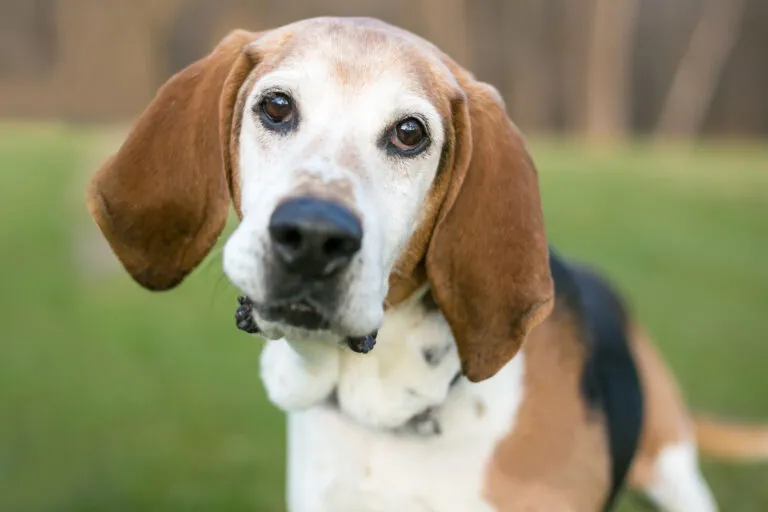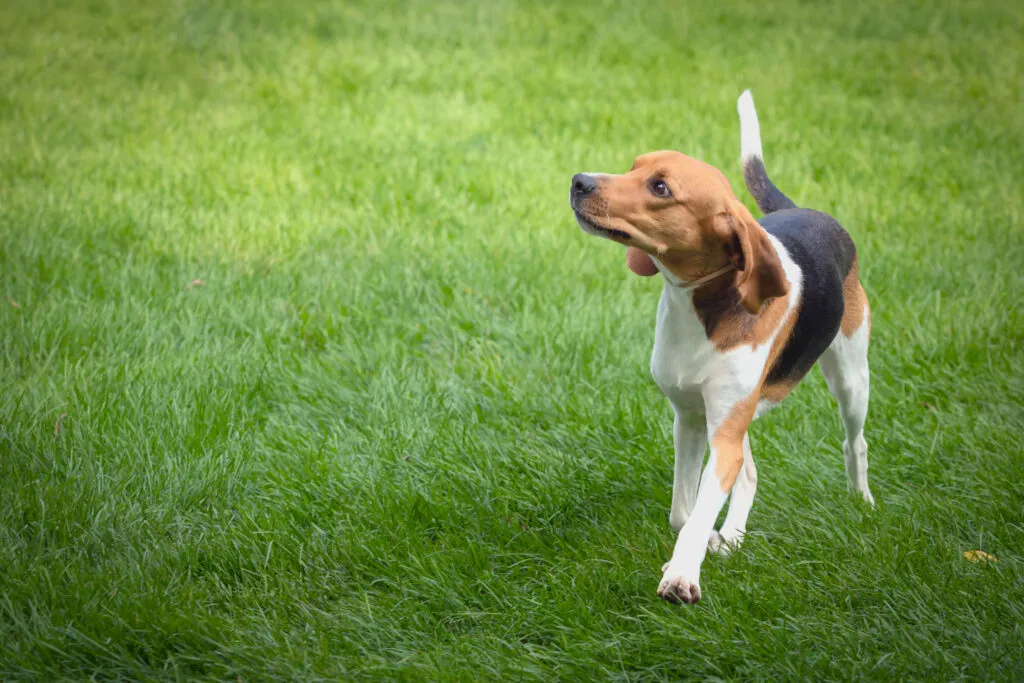Medium Size Poodle
A pack of hounds surrounding mounted hunters in fine attire – this is the image many associate with the English Foxhound breed. These clever Brits are classic scenthounds for fox hunting and are usually reserved for professional hunters for good reasons.

© Mary Swift / stock.adobe.com
Athletic and friendly, the English Foxhound is a classic scenthound.
With a shoulder height between 58 and 64 cm, the English Foxhound weighs about 35 kg. These kilos are well-distributed, reflecting the endurance of this passionate hunting dog: The deep chest accommodates the lungs of a long-distance runner, and the muscles are evenly developed but not bulky.
The long legs allow the Foxhound to run at high speed.
Although their hunting aptitude has always been more important than looks, the Foxhound is still an elegant sight.
According to standards, their harsh fur can come in the following colours: white, white with black, and white with orange.
The English Foxhound is a classic among British hunting dogs. This venerable breed is likely a cross between medieval scenthounds and greyhounds, aiming to add agility to previously more cumbersome trackers.
Their primary role has always been hunting, specifically mounted fox hunts known as “parforce hunts”. In these hunts, a pack pursues game such as deer or foxes until it tires. The enduring hounds can stay on their prey’s heels for up to five hours. They may not outrun their quarry but exhaust it, allowing the human hunter to make the kill.
Parforce hunts peaked in the 18th and 19th centuries, practised by the nobility in Germany, Britain, and France. Only the aristocracy could afford this elaborate form of hunting, often trampling many fields under their horses’ hooves along unpredictable tracks.
 © Andrey / stock.adobe.com
© Andrey / stock.adobe.com
Today, such hunts are banned in the UK and most other European countries. For example, in Germany, the original prohibition, enacted in the 1930s, aimed not at animal welfare but at limiting aristocratic privileges, including hunting rights.
Later hunting laws reinforced the ban. However, this didn’t spell the end for the English Foxhound: Drag hunting, a more animal-friendly alternative, focuses on the delight of the chase rather than the kill.
The FCI recognised the breed in 1964. Besides the English Foxhound, there is also the closely related, slightly lighter American Foxhound.
This friendly dog enjoys pack life, getting along well with other dogs. Owing to its original use and its ancestors’ lifestyle in large packs, the English Foxhound shows good obedience but generally doesn’t form a close bond with individual humans.
These dogs usually grow up and remain in packs. If a closer human attachment is desired, the English Foxhound must be separated from the pack as a puppy, which is not commonly practised since these dogs are primarily professional hunting partners, not companion dogs. The Foxhound retains a certain level of independence and does not have a strong “will-to-please”.
Despite this, the breed is also affectionate: Many Foxhounds love being petted and are quite playful.
Most English Foxhounds are trained for hunting, which is essential. Keeping an English Foxhound as a companion dog can present challenges, as it is a dedicated hunter that forms no strong bond with individual humans. It is particularly difficult to establish a close relationship with a social dog that has lived in a pack for an extended period.
Encourage bonding through shared rituals and positive reinforcement. Rewards don’t always have to be treats – petting or small games can also satisfy this lively dog. The breed is highly social and gets along well with other dogs.
Given its strong hunting instinct, ensure its exercise routine doesn’t disturb the neighbour’s cats or fawns along the path.
Also read about puppy training!
The English Foxhound needs appropriate food, which means: It should contain a lot of meat! Offer your English Foxhound wet- or dry food without getreide, with meat as the main ingredient. For hunting Foxhounds, energy requirements are determined by calories burned – on days with long runs up to 15 km, the dog needs more energy. For high athletic demands, higher-fat food is recommended.
Provide the last meal about three hours before exercise to allow for digestion.
Snacks during longer workouts are usually unnecessary. It is vital that the dog receives a hearty meal and ample rest after the work. The Foxhound is an excellent food utilizer, so watch its waistline and adjust portions if it gains weight.
Dry chews are a welcome variety in the dog’s diet. Avoid feeding tripe, as it is suspected of increasing the risk of Hound Ataxia in Foxhounds.
Ensure plentiful hydration: Foxhounds should be able to drink water at least hourly during hunts. In kennels, always provide fresh water for all dogs.
A healthy Foxhound is generally robust. However, potential owners should be aware of Hound Ataxia, a neurological disorder affecting mainly English Foxhounds and Beagles. It usually appears between the second and seventh years and manifests as movement disorders and spasms. This results from the degeneration of white matter in the spinal cord and grey matter in the brainstem. Although the role of tripe in triggering this condition is unproven, it is advisable to avoid it.
The disease typically progresses without effective treatments. English Foxhounds should also be checked for hip dysplasia before breeding. Preventing obesity is crucial, as under-exercised Foxhounds quickly gain weight.
These dogs can live up to 13 years.
Many kilometres at full gallop – this is what English Foxhounds not only can handle but also enjoy. Drag hunts provide a good alternative to former hunts and are now organised across Europe by drag hunting clubs. During these hunts, the foxhounds follow a fox tail or a scent trail made from tripe water, which drips from containers carried by riders ahead.
If you, although not ideal, keep a non-hunting English Foxhound, you can take it on bike rides or explore sports like Canicross. Your Foxhound should have plenty of space to run – ideally within a large, fenced property with other dogs.
If your dog can no longer hunt due to physical limitations, offer mental stimulation and consider slower scent work, like guided mantrailing, for your dog.
The short, smooth fur of the English Foxhound is easy to maintain. Regular brushing or massage with a grooming glove removes excess hair and is a delight for many dogs.
Especially if you keep an English Foxhound as a companion dog rather than in a pack, establish such bonding rituals from a young age. For older dogs, regularly check the nails to avoid painful snags if they grow too long.
Also, routinely check for parasites in your dogs’ fur and discuss appropriate prophylaxis with your vet.
This dog is undoubtedly for experienced dog owners who also use it for hunting. It is hardly suitable as a companion dog, as few owners can sufficiently exercise this energetic dog. Most English Foxhounds live together in spacious kennels, and usually only non-hunting Foxhounds leave the pack.
Hence, it is not just for enthusiasts but specialists committed to this type of hunting sport and have space for the dog.
If considering a Foxhound as a companion dog, especially one unsuitable for hunting, ensure adequate exercise and previous experience with hunting dogs. Even a non-hunting Foxhound should have a canine companion unless removed from hunting due to intolerances. Clarify the dog’s needs with the pack owner before it moves in.
A fenced garden must be escape-proof. The Foxhound is known to be child-friendly and tends to get along well with children. Pets like cats or rabbits, however, may not make suitable housemates. Some Foxhounds, raised with cats, may accept them as part of their pack, but caution is wiser than regret, and letting a dedicated scenthound into a cat household is generally not a good idea.
This breed is typically bred by hunters for hunters – and rightly so. If you’re keen on keeping these dogs and have the time, money, and space to build a pack, you can gather information from drag hunting clubs. You likely know these already since building a pack without organised hunts makes little sense. Avoid individual Foxhounds bred without papers, whose parents aren’t used for hunting.
These usually come from dubious sellers trying to profit from this classic hunting breed. The puppies are often not pure English Foxhounds but mixes. It’s wiser to look for Foxhound mixes through animal rescue organisations rather than supporting dubious breeding practices.
Those seeking an adult English Foxhound may find one from professional drag hunting packs that occasionally rehome older dogs unsuitable for intense drag hunts. However, ask yourself and discuss honestly with the pack leader if you can provide this sporting dog with a suitable home given its described characteristics.
We hope you have a great time with your athletic English Foxhound!
Fans of the Bearded Collie agree that those who aren't familiar with this dog breed simply have to get acquainted with it. And those who have experienced how a Bearded Collie bolts across meadows with its flowing fur, how it rolls around full of energy and joy and how it attentively and observantly takes into account its owners wishes become simply addicted to this original dog breed and its unique charm.
The Goldendoodle isn't a breed, but a pairing between Golden Retrievers and Medium or Standard Poodles. Marketed as a low-maintenance dog for allergy sufferers, this hybrid is enjoying increasing popularity amongst dog lovers, similar to the Labradoodle.